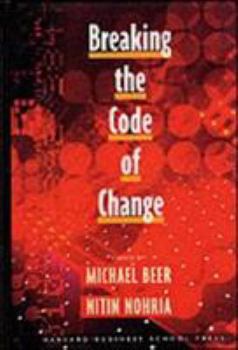Breaking the Code of Change
Select Format
Select Condition 
Book Overview
This work gathers together a collection of debates on organizational change. The articles are arranged into three groups - point counterpoint, and commentary - to give a dynamic, conversational... This description may be from another edition of this product.
Format:Hardcover
Language:English
ISBN:1578513316
ISBN13:9781578513314
Release Date:October 2000
Publisher:Harvard Business Review Press
Length:507 Pages
Weight:2.10 lbs.
Dimensions:1.6" x 6.5" x 9.6"
Customer Reviews
5 ratings
Excellent book on Change Management
Published by Thriftbooks.com User , 13 years ago
This is one of my favourate books of Change management. It opens the topics from various angles and introduce the different camps of the change management.
Human factor and business
Published by Thriftbooks.com User , 20 years ago
Human factor and businessMichael Beer and Nitin Nohria's have present a framework toward as an integrative theory of change. Theory E has as its purpose the creation of economic value, often expressed as shareholder value. Its focus is on formal strong hierarchy structure and systems. It is driven from the top down with extensive help from consultants and financial incentives. There's know room the creative managers. You must agreed to the objects (make and keep the shareholders happiest man in town no matter what) that the top commands and demands. Theory O has as its purpose the development of the organization's human capability to implement strategy and to learn from actions taken about the effectiveness of changes made. Its focus is on the development of a high-commitment culture. Its means consist of high involvement, and consultants and incentives are relied on far less to drive change. Change is emergent, less planned and programmatic. Here there's know place for silos but teamwork and personal development. Resolving the Tension between Theory E and OIt is vary tempting if you find a business model that can boots the business finance, there's a big chance that you will follow that lead. But this can turn out on the short run well for the business and especially for the shareholders. But on the long run this have a great deal of stress on the employers by taken the human factor out of the workspace, and make the workplace a money machine. The authors argue strategies that works only on behave of the shareholders will not survive in the long run. To solve this problem one must look further than the shareholders and deeper than the business objectives (theory O). There must be a cultural transformation. Everyone must work for the same goal and not draining the gaol for the sake of the CEO. To make the cultural transformation, there will be more benefits to the organization in the long run. Finally this will create a win-win situation for the organization employees and the shareholders. Even in the change literature are changing. In breaking the code of change the authors have may very well suggest that the old change agents like Weick, Pettigrew, Bennis, Argyris have lost contact whit the reality, they don't have the vision, the energy. They are not change agents but organization development that help curtain organization to function within the circumstances under the economic situation of that particular moment. At the end of the book Beer and Nohria conclude that these agents didn't succeed to break the code of change. The interesting thing is when you look at the company's the authors consider that make the loop from good to great, you will be surprise if you think that the good to great company's are IBM, Microsoft, Enron, Shell, well not anymore if you're, if you're looking for the company's that embodied the leadership that make the loop from good to great. Don't look for the company's that appear on the front page, or the company'
Finally--clear reasons about what works and what doesn't
Published by Thriftbooks.com User , 21 years ago
When I read this book, I felt that I had been missing the obvious for a long time. The authors provide an explanation about why most of the changes in organizations don't work, whether they are Theory E or Theory O, and how you can combine the two for meaningful and effective results. Their work is based on lots of experience and for me they finally explained what the problem is--and what to do about it. As a change agent, this book gave me great new thinking with which to practice my craft.
A thoughtful, no hype, solid content book
Published by Thriftbooks.com User , 21 years ago
I have just finished reading this book and have been rewarded, as a "change" practitioner, this book adds real value in bringing the streams of change together. It is rare when I read a book on the subject and find it rewarding, enhancing what I do at the coal face. No, quick fix recipes but a thoughtful, well constructed set of ideas that do justice to this complex subject. I would reccomend this book to those who want to get beyond "listmania" and into some real thinking of what is involved in the dynamics of change.
A Must, If You Do Not Wish To Get Lost Between HH.RR & OD
Published by Thriftbooks.com User , 22 years ago
Mike Beer has been for some time now clarifying the issues involved in Corporate Cultures, Human Capital, and Organizational Change. In this recent book Dr. Beer has done what SHOULD have been done decades ago: Linking several fields by providing useful Framework. This book synthesizes fields "apparently" diverse such as: Organizational Design with People & Team Profiling with Organizational Profiling and Human Dynamics. It is a precise, concise, extremely effective, and much needed book.




